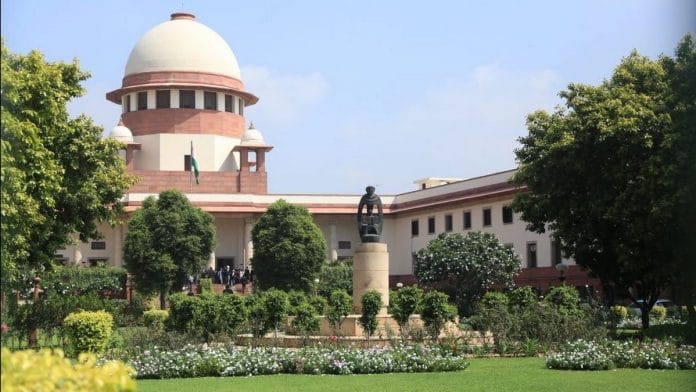New Delhi: The Narendra Modi government may oppose the Supreme Court collegium’s recommendation to elevate chief justices of four high courts to the apex court over issues of seniority and regional representation, ThePrint has learnt.
The government is of the view that the issue of inadequate regional representation — a key factor behind raising the strength of judges in the Supreme Court from 30 to 33 last month — has not been properly addressed in the recent recommendations, said sources.
The collegium ignoring the claim of Orissa High Court Chief Justice K.S. Jhaveri — who stands at number 7 in the all-India seniority of HC judges and is originally from Gujarat High Court — could also be a factor behind the government’s angst, said the sources.
The Supreme Court has only one judge, Justice M.R. Shah, from Gujarat while several other high courts are better represented in the apex court.
A final decision on whether the government should take up the issue of the absence of a proper system in recommending names for elevation will be taken at the “highest level”, added the sources.
Last year, the government took a similar stand during an impasse over the elevation of Uttarakhand High Court chief justice K.M. Joseph.
Recommendations
On 28 August, the five-member Supreme Court collegium headed by Chief Justice of India Ranjan Gogoi recommended four names for elevation to the apex court — Punjab and Haryana HC’s Krishna Murari, Rajasthan HC’s S. Ravindra Bhat, Himachal Pradesh HC’s V. Ramasubramanian and Kerala HC’s Hrishikesh Roy.
In doing so, the collegium chose to ignore — without assigning any detailed reason — several other judges senior to the four chief justices.
In the case of Bhat and Ramasubramanian, the collegium even ignored judges from their parent high courts senior to them.
Opacity has long been associated with the functioning of the collegium system, but the latest recommendations follow a by-now well-established system. Under this, the collegium ignores genuine claims of senior judges and offers just a single line in explanation for its move — it was “conscious of the fact” that it was ignoring judges senior to the ones recommended.
Also read: If collegium has its way, India could soon get its second Dalit CJI
The seniority list
According to official data, Chief Justice Krishna Murari (parent HC Allahabad) is at serial number five in the combined seniority of high court judges on an all-India basis.
S. Ravindra Bhat, originally from Delhi HC, is at number 12. Two high court chief justices — Rajasthan HC’s Pradeep Nandrajog (at number 2) and Jammu and Kashmir HC’s Gita Mittal (at number 11) — were senior to Bhat but have been overlooked by the SC collegium.
Supreme Court judge Sanjay Kishan Kaul (parent HC Delhi) has also raised questions over the collegium’s decision to ignore two chief justices senior to Bhat. In his letter to CJI Gogoi, Kaul reiterated the reservations he expressed in January over bypassing senior candidates.
V. Ramasubramanian, at number 42, is lower on the list than Manipur HC’s chief justice Ramalingam Sudhakar, who is also originally from Madras HC and stands at number 29.
Hrishikesh Roy is at number 45 in the list.
The Joseph case
If the Modi government decides to take on the judiciary over the manner in which it left out senior judges, it will only be following the course of action that it pursued in the case of Justice K.M. Joseph’s elevation.
In May 2018, the government cleared the appointment of Justice Indu Malhotra to the Supreme Court while sending back Joseph’s name to the collegium for reconsideration. The Centre pointed out that Joseph was “placed at serial number 42” and there were “11 chief justices of various high courts who are senior to him”.
Due to the government’s tussle with the judiciary over judges’ appointment, Joseph’s elevation to the top court was delayed by over six months and he lost out on seniority in the Supreme Court.
Also read: Fewer Indian women in higher judiciary? Blame high court collegiums, suggests data







There are occasions when the Chief Justice of a High Court is not considered to be pure as snow. Given how cumbersome the procedures for removal of a Judge are, the Collegium lets him be, does not elevate him to the Supreme Court, despite his seniority. It records a cryptic justification on file, stating that it would not be in the public interest to promote him. 2. There should be a high level of trust between the government and the Collegium. So long as the government does not believe prejudice is at work, it should defer to the Collegium. 3. Read an intriguing fact a couple of days back. If the Collegium reiterates its stand, after considering the government’s reservations, the latter is bound by it. Now the Collegium is expressing fears that a constitutional crisis would arise if the government refuses to act on its affirmation of the original decision. Aise kaise ho sakta hai.